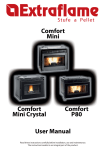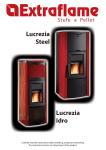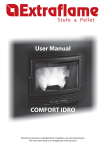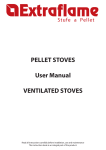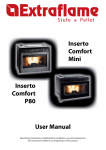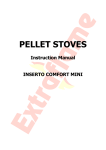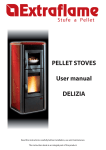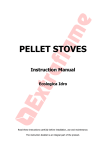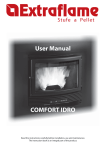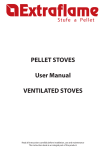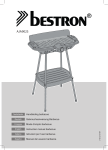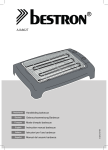Download Extraflame Comfort Mini User manual
Transcript
Comfort Mini Comfort Mini Crystal Comfort P80 User Manual Read these instructions carefully before installation, use and maintenance. The instruction booklet is an integral part of the product. 2 Congratulations! You are now the owner of an Extraflame stove! The Extraflame pellet stove is an ideal heating solution. It utilises the most advanced technology and is manufactured to the highest standards with a contemporary design, allowing you to enjoy the ambience and warmth of a natural flame in complete safety. This manual tells you how to use your stove correctly. Please read the entire manual carefully before using your stove. IMPORTANT Make sure that the dealer completes the following box with the details of the authorised specialist who will help you if you have any problems in using your new pellet stove. AUTHORISED SPECIALIST COMPANY __________________________________________________________________ Full name __________________________________________________________________ Address ______________________________________________ No. __________________ Postal Code ____________ City __________________ County. ______________________ TEL. ________________________________ FAX __________________________________ All Extraflame products are manufactured according to the following directives: 89/106 CEE (Construction Products) 89/366 CEE (EMC Directive) 2004/108 CE (EMC Directive) 2006/95 CE (Low Voltage Directive) And the following standards: EN 14785 EN 60335-1 EN 60335-2-102 EN 61000-3-2 EN 61000-3-3 EN 50366 EN 55014-1 EN 55014-2 3 4 Index WARNINGS AND SAFETY DEVICES.......................................................................................................... 7 Chapter 2 WHAT ARE PELLETS?................................................................................................................................. 8 PELLET STORAGE .....................................................................................................................................................................8 PELLET LOADING .....................................................................................................................................................................8 Chapter 3 SAFETY DEVICES ....................................................................................................................................... 9 BREAKDOWN OF HOT AIR DISTRIBUTION FAN............................................................................................................9 FLUE GAS EXTRACTOR BREAKDOWN..............................................................................................................................9 PELLET LOAD MOTOR BREAKDOWN ...............................................................................................................................9 FAILED IGNITION ......................................................................................................................................................................9 TEMPORARY POWER CUT ....................................................................................................................................................9 ELECTRICAL SAFETY DEVICE ..............................................................................................................................................9 FLUE GAS EXHAUST SAFETY DEVICE ..............................................................................................................................9 PELLET TEMPERATURE SAFETY DEVICE ........................................................................................................................9 Chapter 4 ASSEMBLY AND INSTALLATION INSTRUCTIONS................................................................................. 10 GLOSSARY ............................................................................................................................................................................... 10 INSTALLATION........................................................................................................................................................................ 11 ADMISSIBLE INSTALLATIONS .................................................................................................................................... 11 PROHIBITED INSTALLATIONS .................................................................................................................................... 11 CONNECTION TO THE EXHAUST VENTING SYSTEM ............................................................................................... 12 EXHAUST CHANNEL OR PIPE .................................................................................................................................... 12 CHIMNEY OR SINGLE FLUE ........................................................................................................................................ 13 CONNECTION TO THE FLUE AND COMBUSTION PRODUCT EXHAUST VENTING ................................ 15 CHIMNEY CAP ................................................................................................................................................................. 15 CONNECTION TO EXTERNAL AIR INTAKES ................................................................................................................. 16 INSULATION, TRIMS, FACINGS, AND SAFETY PRECAUTIONS.............................................................................. 16 NATIONAL, REGIONAL, PROVINCIAL AND MUNICIPAL LAWS ............................................................................ 16 Chapter 5 COMFORT MINI/P80/MINI CRYSTAL INSTALLATION ........................................................................... 17 FITTING WITH SLIDING BASE ........................................................................................................................................... 17 INSTALLATION WITH PEDESTAL (OPTIONAL) ............................................................................................................ 18 INSTALLATION WITH PEDESTAL...................................................................................................................................... 18 EXTRACTING THE INSERT .................................................................................................................................................. 19 FITTING THE FRAMES .......................................................................................................................................................... 19 AIR CIRCULATION DUCTS .................................................................................................................................................. 20 Chapter 6 REMOTE CONTROL OPERATION ............................................................................................................ 23 GENERAL DESCRIPTION ..................................................................................................................................................... 23 GENERAL FEATURES ............................................................................................................................................................ 24 KEYPAD ..................................................................................................................................................................................... 24 DISPLAY .................................................................................................................................................................................... 24 Chapter 7 PRODUCT FUNCTIONALITY ................................................................................................................... 26 BASIC INSTRUCTIONS ......................................................................................................................................................... 26 5 IGNITION .................................................................................................................................................................................. 26 NORMAL OPERATION ......................................................................................................................................................... 27 SHUTDOWN ............................................................................................................................................................................ 27 Chapter 8 USER MENUS ........................................................................................................................................... 28 SET TEMPERATURE MENU ................................................................................................................................................. 29 SET CLOCK MENU ................................................................................................................................................................. 29 SET TIMER MENU .................................................................................................................................................................. 29 DAY/NIGHT MENU ................................................................................................................................................................ 31 PELLET LOAD MENU ............................................................................................................................................................ 32 LANGUAGE MENU ................................................................................................................................................................ 33 Chapter 9 ROOM THERMOSTAT .............................................................................................................................. 34 MECHANICAL THERMOSTAT (OPTIONAL) .................................................................................................................. 34 INSTALLING A MECHANICAL THERMOSTAT (OPTIONAL)..................................................................................... 34 MECHANICAL THERMOSTAT OPERATION ................................................................................................................... 34 MECHANICAL THERMOSTAT OPERATION IN STANDBY MODE (TO BE USED ALSO FOR REMOTE ACTUATOR) ............................................................................................................................................................................. 34 Chapter 10 CLEANING ................................................................................................................................................ 36 CLEANING THE BRAZIER .................................................................................................................................................... 36 USE OF SCRAPERS ................................................................................................................................................................ 36 CLEANING OF ASH COLLECTION COMPARTMENTS ............................................................................................... 36 CLEANING THE HEAT EXCHANGER (MONTHLY) ....................................................................................................... 36 DOOR, ASH DRAWER AND BRAZIER SEALS................................................................................................................ 37 CHIMNEY CONNECTION .................................................................................................................................................... 37 BRAZIER PARTITION ............................................................................................................................................................. 38 Chapter 11 TABLE OF DISPLAY MESSAGES .............................................................................................................. 39 Chapter 12 WARRANTY .............................................................................................................................................. 42 6 Chapter1 WARNINGS AND SAFETY DEVICES The stoves produced by our establishment are built with attention to the individual components in a way to protect both the user and the installer from any accidents. It is therefore recommended that after any intervention on the product, authorised staff pay particular attention to the electric connections, especially the stripped parts of the wires. These must not escape from the terminal board in any situation, thus preventing possible contact with the live parts of the wire. Installation must be carried out by authorised staff, who must provide the buyer with a declaration of conformity for the system and will assume full responsibility for final installation and as a consequence the correct functioning of the installed product. It is necessary to bear in mind all laws and national, regional, provincial and town council Standards present in the country the appliance has been installed. Extraflame S.p.A. cannot be held responsible for the failure to comply with such precautions. The instruction manual is an integral part of the product: make sure that it always accompanies the appliance, even if transferred to other owners or user or is transferred to another place. If it is damaged or lost, request another copy from the area technician. This stove must be destined for the use for which it has been expressly realised. The manufacturer is exempt from any liability, contractual and extracontractual, for injury/damage caused to persons/animals and objects, due to installation, adjustment and maintenance errors and improper use. After the packaging has been removed, check the integrity and completeness of the contents. If this does not comply, contact the dealer where the appliance was purchased. All electric components that make up the stove must be replaced with original spare parts exclusively by an authorised after-sales centre, thus guaranteeing correct functioning. manufacturer. Do not pull, disconnect, twist electric cables leaving the stove, even if disconnected from the electric power supply mains. Do not close or reduce the dimensions of the airing vents in the place of installation. The airing vents are indispensable for correct combustion. Do not leave the packaging elements within reach of children or unassisted disabled persons. The hearth door must always be closed during normal functioning of the product. Avoid direct contact with parts of the appliance that tend to heat up during functioning. Check for the presence of any obstructions before switching the appliance on following a prolonged standstill period. The stove has been designed to function in any climatic condition (also critical). In particularly adverse conditions (strong wind, freezing) safety systems may intervene that switch the stove off. If this occurs, contact the technical after-sales service and always disable the safety system. If the flue should catch fire, be equipped with suitable systems for suffocating the flames or request help from the fire service. MAJOLICAS The company have chosen majolica tiles, which are the result of high-quality artisan work and therefore the majolica may present crackles, speckles, and shadings. These characteristics certify their precious origin. Enamel and majolica, due to their different coefficient of dilatation, produce microcrackles, which show their authentic feature. For the cleaning of the majolica we suggest you use a soft and dry cloth; if you use a detergent or liquid, the latter might soak in and make the crackles more visible. The stove must be serviced at least once a year, programming it in advance with the technical after-sales service. Nota bene: In case of thermo product or boiler, the product or system venting is not covered by the warranty. For safety reasons, remember that: The stove must not be used by children or unassisted disabled persons. Do not touch the stove when you are barefoot or when parts of the body are wet or humid. The safety and adjustment devices must not be modified without the authorisation or indications of the WARNINGS AND SAFETY DEVICES 7 Chapter2 WHAT ARE PELLETS? Pellets are made by applying very high pressure to sawdust; i.e. the residue of raw timber (without paint) produced by sawmills, carpentry works and other activities involved in processing wood. This type of fuel is completely environmentally friendly, as no binders of any kind are used to keep it compact. In fact, the compactness of the pellets over time is guaranteed by lignite, a natural substance found in the wood itself. As well as being an environmentally friendly fuel, since wood residues are exploited to the maximum, pellets also have technical advantages. The density of the pellet is 650kg/m3 and the water content is 8% of its weight. For this reason, pellets do not need to be seasoned to obtain a sufficient heating yield. The pellet used must conform to the characteristics of the following regulations: Ö-Norm M 7135 DIN plus 51731 UNI CEN/TS 14961 Extraflame recommends always using 6 mm pellets for its products. PELLET STORAGE To guarantee problem-free combustion, the pellet must be stored in a dry place. PELLET LOADING Pellets can either be loaded from the front, by removing the insert, or from the side, by using the chute, if equipped with the support and loading kit. WARNING!!! THE USE OF POOR QUALITY PELLETS OR ANY OTHER MATERIAL MAY DAMAGE THE YOUR STOVE AND MAY LEAD TO THE INVALIDATION OF THE WARRANTY AND THE RELATED RESPONSIBILITIES OF THE MANUFACTURER. 8 WHAT ARE PELLETS? Chapter3 SAFETY DEVICES BREAKDOWN OF HOT AIR DISTRIBUTION FAN If the blower stops for any reason, the stove automatically shuts down to prevent overheating. FLUE GAS EXTRACTOR BREAKDOWN If the extractor stops, the electronic unit immediately prevents pellet loading. PELLET LOAD MOTOR BREAKDOWN If the motor stops, the stove continues to operate until the minimum cooling level is reached. FAILED IGNITION If no flame develops during the ignition phase, the appliance automatically attempts a new ignition, this time, though, without loading pellets. If, after this attempt, the stove still has no flame, the stove display shows “NO FLAME”. If you attempt to light the stove again, the display shows “CLEANING WAIT” which means “WAIT”. This function reminds you that before lighting the stove, you must be sure that the brazier is free of dirt and debris. TEMPORARY POWER CUT The appliance will re-light automatically after a brief power failure. When the power goes off, the stove may emit a minute quantity of smoke inside the house for a period of 3 to 5 minutes. THIS DOES NOT POSE ANY SAFETY RISK. ELECTRICAL SAFETY DEVICE The stove is protected against violent changes in power by a master fuse on the rear of the stove (2A 250V delayed). FLUE GAS EXHAUST SAFETY DEVICE If the exhaust system fails, an electronic pressure switch stops the stove and an alarm is signalled. PELLET TEMPERATURE SAFETY DEVICE In case of overheating inside the pellet tank, this safety device blocks stove operation; resetting is manual and must be performed by an authorised technician. SAFETY DEVICES 9 Chapter5 ASSEMBLY AND INSTALLATION INSTRUCTIONS The installation must comply with: UNI 10683 (2005) heat generators fed with wood and other solid fuels: installation. The chimneys must comply with: UNI 9731 (1990) chimneys: classification according to thermal resistance. EN 13384-1 (2006) calculation method of the thermal and fluid-dynamic features of the chimney. UNI 7129 point 4.3.3 provisions, local rules and prescriptions of the fire brigade. UNI 1443 (2005) chimneys: general requirements. UNI 1457 (2004) chimneys: internal ducts in terracotta and ceramics. GLOSSARY CLOSED HEARTH DEVICE Heat generator that can only be opened to load fuel during use. BIOMASS Material of organic origin, excluding the material incorporated in geological formations and fossilised. BIOFUEL Fuel produced directly or indirectly from biomass. FLUE or CHIMNEY Vertical duct for collecting and expelling combustion products from a single appliance at a suitable height from the floor. EXHAUST CHANNEL OR PIPE Duct or connecting element between the heat generating device and the chimney for extracting the combustion products. INSULATION The series of measures taken and materials used to prevent heat transmission through a wall dividing rooms at different temperatures. CHIMNEY CAP Device located at the top of the chimney that facilitates dispersion of the combustion products in the atmosphere. CONDENSATE Liquid products that form when the temperature of the combustion gas is lower than or equal to the dew point of the water. HEAT GENERATOR Device that permits the production of thermal energy (heat) by the rapid transformation of the chemical energy of the fuel by means of combustion. AIR LOCK Mechanism for modifying the dynamic resistance of the combustion gasses. 10 ASSEMBLY AND INSTALLATION INSTRUCTIONS Chapter5 EXHAUST VENTING SYSTEM A system for fume exhaust venting that is independent from the appliance, composed of a pipe or channel, chimney or single flue, and chimney cap. FORCED DRAUGHT Air circulation by means of a fan driven by an electric motor. NATURAL DRAUGHT Draught resulting in a chimney/flue due to the difference in the volume mass existing between the (hot) fumes and the surrounding atmospheric air, without any mechanical suction aid installed inside or on top of it. RADIANCE AREA Area immediately adjacent to the hearth in which the heat produced by combustion is diffused; this area must not contain any objects made of combustible material. REFLUX AREA Area in which the combustion products come out from the appliance towards the room in which it is installed. INSTALLATION Before carrying out installation, it is necessary to check the positioning of the chimneys, flues or exhaust terminal ducts of the appliance, keeping in mind the following: Installation prohibitions Legal clearances Limitations set forth by local administrative regulations or specific regulations of the authorities. Common limitations deriving from building regulations, and easement or contract regulations. ADMISSIBLE INSTALLATIONS In the room in which the heat generator is to be installed, any existing or installed appliances must be airtight to the room and must not cause depression in the room with respect to the external environment. Appliances used for cooking foods and the related hoods without extractor can only be installed in rooms used as kitchens. PROHIBITED INSTALLATIONS The room in which the heat generator is to be installed must not contain any of the following devices, either pre-existing or installed: Hoods with or without extractor; Ventilation ducts of the collective type. Should these devices be located in adjacent rooms communicating with the installation room, it is forbidden to use the heat generator simultaneously where there is the risk that one of the two rooms may be subject to depression with respect to the other. ASSEMBLY AND INSTALLATION INSTRUCTIONS 11 Chapter5 CONNECTION TO THE EXHAUST VENTING SYSTEM EXHAUST CHANNEL OR PIPE For the assembly of the exhaust channels it is imperative to use non-flammable materials that are resistant to combustion products and any condensates. It is forbidden to use flexible metal pipes and asbestos cement for connecting the stove to the flue, also for preexisting exhaust channels. There must be continuity between the exhaust channel and the flue so that the flue does not lean on the stove. The exhaust channels must not pass through rooms in which the installation of combustion devices is forbidden. The assembly of the exhaust channels must be carried out in such a way as to ensure that they are airtight for the operating conditions of the appliance, as well as to limit the formation of condensates and prevent them from being conveyed towards the appliance. The assembly of horizontal sections must be avoided where possible. Where roof or wall exhaust outlets have to be reached that are not coaxial in relation to the exhaust outlet from the appliance, the direction changes must be made using open elbows no greater than 45° (see figures below). Insulation < 45° < 45° Flue Inspection figure 5.1 figure 5.2 For heat generating devices equipped with an electric exhaust fan, i.e. all products made by Extraflame, it is necessary to observe the following instructions: Horizontal sections must have a minimum slope of 3% upwards. The length of the horizontal section must be as short as possible, and in any case no greater than 3 meters. No more than four direction changes may be used, including the one resulting from the use of the “T”element. (When four bends are used, use double wall piping with a 120 mm diameter.) In any case, exhaust channels must be sealed in relation to combustion products and condensates, as well as insulated, if they pass outside the installation room. It is forbidden to use elements in counter-slope. The exhaust channel must allow soot recovery and cleaning using a swab. The exhaust channel must have a constant cross-section. Any changes in cross-section are allowed only at 12 ASSEMBLY AND INSTALLATION INSTRUCTIONS Chapter5 the flue connection. It is forbidden to run other air feed channels or piping for utilities inside the exhaust channels, even if they are oversized. It is also forbidden to fit manual draught adjustment devices on the forced draught appliance. CHIMNEY OR SINGLE FLUE The chimney or flue must meet the following requirements: be airtight to combustion products, waterproof and properly insulated according to the usage conditions; be made of materials suitable to resist normal mechanical stress, as well as heat and the action of combustion products and any condensates; have a predominantly vertical layout with deviations from the axis no greater than 45°; be situated at a proper distance from combustible or flammable materials by means of an air gap or suitable insulation material; 20 cm Minimum80 cm2 C B A Floor protection figure 5.3 figure 5.4 REFERENCES A B C Flammable objects 200 1500 200 Non-flammable objects 100 750 100 preferably have a round internal section: square or rectangular sections must have rounded edges with radius no less than 20 mm; have a constant, free and independent internal section; have rectangular sections with a maximum ratio between sides of 1.5. The exhaust duct should be equipped with a chamber for the collection of solid materials and any condensates located below the mouth of the exhaust channel, so that it is easy to open and inspect from the airtight hatch. ASSEMBLY AND INSTALLATION INSTRUCTIONS 13 Chapter5 Windproof chimney cap <3m 3-5% Flue Inspection Inspection figure 5.5 figure 5.6 <3m External insulated duct 45° 45° Inspection Inspection figure 5.7 14 figure 5.8 ASSEMBLY AND INSTALLATION INSTRUCTIONS Chapter5 CONNECTION TO THE FLUE AND COMBUSTION PRODUCT EXHAUST VENTING The flue must receive exhaust from a single heat generator. Direct discharge towards enclosed areas, even when roofless, is forbidden. Direct discharge of combustion products must take place on the roof and the exhaust duct must have the features set forth in the section “Chimney or single flue”. CHIMNEY CAP The chimney cap must meet the following requirements: have an internal section equivalent to that of the chimney; have a useful outlet section no less than twice the internal section of the chimney; be constructed in such a way as to prevent the penetration of rain, snow and foreign bodies into the chimney, as well as to assure the discharge of the combustion products also in the presence of winds coming from any direction and at any angle. be positioned in such a way as to assure proper dispersion and dilution of the combustion products and, in any case, outside the reflux area in which the formation of counter-pressure is most likely to occur. This area has different sizes and shapes depending on the slope of the roof; therefore, it is necessary to use the minimum heights indicated in the figures below. The chimney cap must not have any mechanical suction devices. FLAT ROOF 50 cm 50 >5m <5m <5m figure 5.9 SLOPED ROOF Distance > A Distance < A 50 cm beyond the ridge beam REFLUX AREA Reflux area height H min β figure 5.10 ASSEMBLY AND INSTALLATION INSTRUCTIONS 15 Chapter5 Roof pitch β 15° 30° 45° 60° CHIMNEYS, DISTANCES AND POSITIONING Distance between the Minimum height of the chimney crown and the chimney (measured from the outlet) A (m) H (m) < 1,85 0,50 m beyond the crown > 1,85 1,00 m from the roof < 1,50 0,50 m beyond the crown > 1,50 1,30 m from the roof < 1,30 0,50 m beyond the crown > 1,30 2,00 m from the roof < 1,20 0,50 m beyond the crown > 1,20 2,60 m from the roof CONNECTION TO EXTERNAL AIR INTAKES To ensure correct operation, the appliance must have sufficient air available by means of external air intakes, which must meet the following requirements: 1. They must have a total free section of at least 80 cm2. 2. They must be protected by a grate, metal mesh, or other suitable protection provided that it does not reduce the minimum section as per point a) and that it is positioned in such a way as to prevent the intakes from being obstructed. If the combustion air is collected directly from the outside by means of a pipe, it is necessary to fit a downward bend or a wind hood on the outside. In addition, no grating or similar device should be positioned. (Extraflame S.p.A. suggests creating an air intake directly communicating with the installation room, even if air is collected from outside by means of a pipe). Air inflow can also be obtained from a room adjacent to the installation room, provided that the flow can occur freely through permanent openings communicating with the outside. The adjacent room must not be subject to depression with respect to the outside as a result of the opposing draught caused by the presence of another utility device or suction device in this room. In the adjacent room, the permanent openings must meet the requirements described above. The adjacent room cannot be used as a garage, storage area for combustible material, or for activities involving fire hazards. INSULATION, TRIMS, FACINGS, AND SAFETY PRECAUTIONS The facings, no matter what type of material they are made of, must constitute a self-bearing structure with reference to the heating assembly and not in contact with it. The beam and the trims in wood or combustible materials must be positioned outside of the radiant area of the hearth or be properly insulated. If the space above the heat generator has coverings made of combustible or heat-sensitive material, a protective membrane made of non-combustible insulating material must be placed between it and the generator. All elements made of combustible or flammable material, such as wooden furnishings, curtains, etc., that are directly exposed to the radiance of the hearth must be placed at a safe distance. The installation of the appliance must guarantee easy access for cleaning the appliance itself, of the waste gas pipes and the flue. NATIONAL, REGIONAL, PROVINCIAL AND MUNICIPAL LAWS All the national, regional, provincial ad municipal laws of the country where the appliance has been installed must be taken into consideration. 16 ASSEMBLY AND INSTALLATION INSTRUCTIONS Chapter5 COMFORT MINI/P80/MINI CRYSTAL INSTALLATION The insert is supplied with a sliding base in iron, which allows it to be installed in a pre-existing chimney. The base allows you to slide out the insert easily for maintenance and cleaning at the end of the year. If you do not already have a fireplace, you can build one using the insert support pedestal (optional kit), which is designed to secure the insert to the floor. Description of the components: Sliding base Guide rails Exhaust pipe Primary air inlet pipe Power outlet Adapter frame FITTING WITH SLIDING BASE Adaptation frame Sliding base with rails Primary air intake pipe figure 5.1 Take the sliding base and place it in the existing fireplace. Using chalk, mark the base fixing holes on the floor of the fireplace. Drill the holes for 8 mm steel screw anchors. Drill a 60 mm hole in correspondence with the air inlet. The air inlet must be made outside the fireplace, because it must not draw in overheated air. Provide a power outlet on the rear of the insert, so that the plug can be reached easily once the installation is complete. Fix the base using the attachment screws. Make the connection to the exhaust outlet and air inlet, following the instructions previously described. Then tilt the insert so that the wheels fit into the guide rails and slide it in until the exhaust auger coupling is completely inserted in the exhaust conveyor box. figure 5.2 figure 5.3 COMFORT MINI/P80/MINI CRYSTAL INSTALLATION 17 Chapter5 Finally, open the fire door and use the socket wrench provided to turn the screw in the lower left-hand corner clockwise. To check that the insert is correctly coupled with the base, connect the plug to the power outlet: the display should light up. The insert must stand at least 1 cm above the marble fire top of the facing. INSTALLATION WITH PEDESTAL (OPTIONAL) Description of components: Comfort Mini/P80/Crystal Pedestal adjustable in height Side feeding tank Adjustable tank support figure 5.4 INSTALLATION WITH PEDESTAL Position the base in the desired point and adjust to the desired height using the feet (the bolts are located on the four outer edges of the pedestal at the bottom). Provide a power outlet on the rear of the pedestal that will be easy to reach once the installation is complete. Fix the pedestal to the floor using strong steel screw anchors with an 8 mm diameter. Fix the sliding base to the frame using the bolts. Connect the exhaust outlet and air inlet as described in the previous section. Then tilt the insert so that the wheels fit into the guide rails, slide it until the exhaust auger coupling is completely inserted in the exhaust conveyor box. Then use the socket wrench provided to turn the screw anticlockwise. To check that the insert is correctly coupled with the base, connect the plug to the power outlet: the display should light up. Fit the tank support as shown in Fig. 10. Insert the support in the coupling provided. N.B.: When using our pedestal, it is necessary to create an inspection window in the chimney that allows you to check the pellet level in the tank while filling it. figure 5.5 figure 5.6 18 COMFORT MINI/P80/MINI CRYSTAL INSTALLATION Chapter5 The tank support can only be fitted on the right-hand side of the insert. Adjust the height and angle of the tank according to the fireplace to be built. The insert must stand at least 1 cm above the marble fire top of the facing. EXTRACTING THE INSERT Extraction of the insert allows to feed the pellets into the tank and to perform routine maintenance (cleaning the ash chute every year) or extraordinary maintenance (replacement of mechanical parts if the product should break). figure 5.7 These operations must be carried out by an authorised technician, with the stove switched off and the plug disconnected. To extract the insert, proceed as follows: 1. Open the fire door and use the socket wrench provided to turn the screw in the lower left-hand corner anticlockwise. 2. Using the pokers provided, pull the insert towards you until it blocks automatically. FITTING THE FRAMES Front frame Side frames figure 5.8 Attach the front frame to the two side frames. Fix the frames to the insert using self-tapping screws. N.B. Any wooden beams situated above the insert must be protected using fireproofing material. Frame assembly is important, as it allows correct air circulation in the insert and consequently the most efficient stove operation. figure 5.9 The 2 side frames are fitted to the upper frame using 2 screws per side. The remaining holes on the side frames are used for attaching the entire frame assembly to the sides of the insert using self-tapping screws. COMFORT MINI/P80/MINI CRYSTAL INSTALLATION 19 Chapter5 AIR CIRCULATION DUCTS For correct function air circulation must be created inside the structure that covers the insert in order to prevent the appliance overheating. The following measurements must be respected: Lower part (cold air inlet) D total minimum surface 550 cm2. Upper part (hot air outlet) D total minimum surface 500 cm2. This ventilation system is completely independent from the combustion air inlet!! To protect against overheating, the comfort P80 is supplied with a probe that analyses the temperature inside the structure and intervenes by reducing the functioning power. Comfort Mini / Comfort Mini Crystal Comfort P80 figura 5.10 figura 5.11 H figura 5.12 20 H figura 5.13 COMFORT MINI/P80/MINI CRYSTAL INSTALLATION Chapter5 Comfort Mini / Comfort Mini Crystal Comfort P80 5 cm 5 cm 5 cm figura 5.14 5 cm 5 cm figura 5.15 It is also important to guarantee the minimum distance of 5 cm on both sides as illustrated in figures 6.14 - 6.15. COMFORT MINI/P80/MINI CRYSTAL INSTALLATION 21 Chapter5 A Warm convection air It is necessary provide an outlet for the heat accumulated in the facing to prevent excessive overheating of the insert. 5 cm ventilation B Forced The blower conveys the heat produced in the insert into the room. C Air inlet from the room To enable air circulation, it is necessary to have an air inlet point, preferably at the lower part of the structure, for better convection. The air must be drawn from the room where the stove is installed. figure 5.16 To ensure the correct and safe operation of the insert, when building the fireplace it is necessary to respect the clearances between the insert and the inner walls of the fireplace. Considering the measurements given in the technical specifications, you need to account for at least 50 mm of air space in the upper part and on the two sides. The exhaust outlet pipe must always be at a minimum distance of 5 cm from flammable parts. 22 COMFORT MINI/P80/MINI CRYSTAL INSTALLATION Chapter6 REMOTE CONTROL OPERATION GENERAL DESCRIPTION The radio-frequency remote control has two-way communication with the electronic board, sending commands and displaying the operating status of the stove. Certain radio-frequency devices (e.g. mobile or cordless phones, etc.) can interrupt the communication between the remote control and the stove. Selecting the operating frequency During the first stove lighting, it is necessary to establish a communication frequency between the remote control and the stove. With this procedure it is possible to select one of 4 possible coding methods: this also makes it possible to use more than one stove inside the same room without one interfering with the operation of the other. The coding procedure is as follows: 1. Disconnect the power supply from the stove. 2. Remove the batteries form the remote control. 3. Reposition the batteries in the remote control. 4. Press buttons 4 and 5 together for three seconds, until “CHOOSE UNIT” appears on the display. 5. Use button 4 or 5 to select the desired coding (from 0 to 3). 6. Power up the stove. 7. The stove will emit two acoustic signals: between the first and the second, press button 1 for 1 second. At this point, the display will show “EXTRAFLAME” If communication between remote control and the chimney is very disturbed or inaccurate, the remote control can be directly connected to the device via cable, as illustrated below. Comfort Mini / Comfort Mini Crystal Comfort P80 figure 6.1 figure 6.2 figure 6.4 REMOTE CONTROL OPERATION figure 6.3 figure 6.5 23 Chapter6 GENERAL FEATURES The visual interface is given on an LCD display with 24 characters on 4 lines plus 16 bars. Transmission and reception capacity: 4 metres in free air space. Display of the operating status of the product Direct controls for switch-on/off, power setting change Button 4 Weekly programmer setting Battery power supply (two 1.5 V AA batteries) Dimensions: 61 x 150 x 120 (D x L x W) mm. LCD Display Button 1 Button 5 KEYPAD Button 3 Button 2 Button 1 – ON/OFF unblock Pressing this button for two seconds enables the manual switch-on/off of the stove. If the stove is in alarm status, and therefore blocked, the button is used for unblocking and subsequent passage to OFF status. During the programming of the user parameters, it is used to exit and return to the previous menu. figure 6.6 Buttons 4 and 5 – Parameter increase/decrease On the main screen. These buttons are used for regulating the operating power of the stove from a minimum setting of 1 to a maximum of 5; this value is shown on the upper display. During modification of the user parameters, the buttons are used for increasing/decreasing the value of the parameter, which is shown on the first line of the display. Menu 1 (3) and Menu 2 (2) buttons These buttons are used for accessing and setting the user parameters. DISPLAY The display message changes in relation to the status of the stove, or the menu being display. In resting status, the display shows the following: TIME: The current time is shown. The time is set within the weekly programmer (see SET CLOCK menu). ROOM TEMPERATURE: Shows the current room temperature. HEATING POWER: Indicates the operating power. It is set by the user during stove operation. STOVE STATUS: Shows whether the stove is off or on. 24 REMOTE CONTROL OPERATION Chapter6 20:00 TIME 21° C Po 4 ROOM TEMPERATURE HEATING POWER WORKING STOVE STATUS figure 6.7 REMOTE CONTROL OPERATION 25 Chapter7 PRODUCT FUNCTIONALITY BASIC INSTRUCTIONS The stove you have purchased uses pellets as fuel. This type of material is produced from natural waste from woodworking. By means of a special process, which does not require the use of any binders or additives, the shavings are compressed in industrial machines under high pressure and become solid wooden pellets. IT IS STRICTLY FORBIDDEN to burn any other material besides pellets in our stove. Failure to respect these instructions will void all warranties and may jeopardise the safety of the appliance. The first two or three times the stove is lit, the following recommendations should be observed: No children should be present, as the vapours emitted can be harmful for health. Adults, too, should not stay in the vicinity for very long. Do not touch the surfaces, as they could still be unstable. Air the room thoroughly several times. The hardening of the surfaces is completed after several heating processes. This stove must not be used as a waste incinerator. IGNITION 1. Before proceeding, check to make sure that: the tank is loaded with pellets the combustion chamber is clean the brazier is clean and free the fire door and the ash drawer are sealed the power cable is connected correctly the two-way switch on the back of the stove is in position 1 2. Press button 1 for three seconds; display D1 will show the message “START”. During this stage, the stove carries out an automatic check on the efficiency of each single electrical component. When this cycle is completed, display D1 shows the message “IGNITION 15” (the number of minutes for which the stove attempts the lighting stage, decreasing by 1 every minute that passes). The first time the stove is used, even if the tank is loaded with pellets, it is possible that the pellets are not distributed to the combustion chamber for the first 15 minutes because the worm screw for loading the pellets is empty. If the stove has not developed a flame after the fifteen minutes have elapsed, the display shows the message “NO FLAME”. 3. If points 1 and 2 are carried out correctly, the stove will enter the “START UP 07” stage. 4. After the lighting phase, the stove will enter the working phase and the display will show the room temperature, heating power and stove status. WARNING!!! 1. NEVER USE FLAMMABLE LIQUIDS FOR LIGHTING 2. WHEN FILLING, DO NOT BRING THE SACK OF PELLETS INTO CONTACT WITH THE HOT STOVE In case of continued ignition failures, contact an authorised technician. 26 PRODUCT FUNCTIONALITY Chapter7 NORMAL OPERATION When the stove has been lit, the user can adjust the heating power using buttons 4 and 5. By pressing 4, the heating power and the pellet consumption will decrease, while by pressing 5 it will increase. In addition to the feed rate, the room temperature can be set directly from the control panel. The stove adjusts itself automatically as far as warm air ventilation is concerned. The contents of the tank should be monitored to prevent the stove going out because of a lack of fuel. WARNING!!! The cover of the pellet container must be kept closed, except when loading fuel. The sacks of pellets, must be kept at least 1.5 metres away from the stove. The pellet tank should always be kept half full. The appliance should be switched off before filling with pellets. SHUTDOWN Press button 1 for three seconds. When the three seconds have elapsed, the stove automatically starts the shutdown stage, cutting off the pellet load; the display will show “FINAL CLEANING” . Both the exhaust motor and warm air ventilation motor continue to run until the stove temperature has dropped sufficiently. When the exhaust motor stops, the display will show “OFF”. PRODUCT FUNCTIONALITY 27 Chapter8 USER MENUS The table below shows the various menus available to the user: No. 1 2 3 4 5 6 Menu Set temperature Set clock Set timer Day/Night Pellet load Set Language Description Menu for setting the temperature Menu for setting the current day and time Menu for setting the switch-on/off programmes Menu for day/night temperature function Menu for adjusting the pellet load % Menu for selecting the language The diagram below shows how the various user menus are accessed: MAIN SCREEN menu 1 SET TEMPERATURE menu 2 See Temperature Set Menu menu 2 See Clock Set Menu menu 2 See Timer Set Menu menu 2 See Day/Night Menu menu 2 See Pellet Adjustment Menu menu 2 See Language Menu menu 2 SET CLOCK button 5 SET TIMER button 5 DAY/NIGHT button 5 PELLET FEED button 5 SET LANGUAGE 28 USER MENUS Chapter8 SET TEMPERATURE MENU The temperature value can be changed at any time by the user. Press the menu 1 button; the display shows “ROOM TEMP SET”. Then use buttons 4 and 5 to select the desired temperature value: the buttons enable the increase/decrease of the room thermostat value from a minimum of 07°C (the display shows MIN) to a maximum of 40°C (the display shows MAX). This value is shown on the first line of the display; the third and fourth lines show “ROOM TEMP SET”. When you have set the desired value, confirm with button 1. SET CLOCK MENU This procedure is used for activating/deactivating the weekly programmer and setting the current time. The procedure can be carried out with the stove on or off, as follows: 1. Press the menu 1 button D the display will show “ROOM TEMP SET” 2. Press the menu 1 button again D the display will show “CLOCK SET MENU” 3. Confirm with the menu 2 button When you have entered the programming function, the display will show the following parameters: Parameter 1 Î CLOCK DAY Used for setting the following values: “day1”… “day7” D use buttons 4 and 5 to set the current day of the week. When the current day has been set, the weekly programmer function is automatically enabled. To confirm and continue with programming, press the menu 2 button. To return to the previous parameter, press the menu 1 button. Parameter 2 Î CLOCK HOURS Use buttons 4 and 5 to set the current hour. To confirm and continue with programming, press the menu 2 button. To return to the previous parameter, press the menu 1 button. Parameter 3 Î CLOCK MINUTES Use buttons 4 and 5 to set the current minutes. To confirm and continue with programming, press the menu 2 button. To return to the previous parameter, press the menu 1 button. If you make an error in programming, exit with button 1 and repeat the steps described above. SET TIMER MENU The weekly programmer enables you to set three heating periods over the course of the day, to be used for each day of the week. The timetables for switch-on/off must be consecutive within the same day, on a 24-hour basis (from 0 to 24), and not straddling more than one day: e.g.: Switch-on 07.00 / switch-off 18.00 Switch-on 22.00 / switch-off 05.00 USER MENUS OK ERROR 29 Chapter8 The programming procedure can be carried out with the stove on or off, and involves the following steps: 4. Press menu 1 D the display will show “ROOM TEMP SET” 5. Press menu 1 again D the display will show “MENU SET CLOCK” 6. Press button 5 D the display will show “CRONO SET MENU” 7. Press menu 2 to confirm Once you enter the programming area, the display will show the following: Parameter ut 0 D CRONO ON-OFF Use buttons 4 and 5 to enable/disable the weekly programmer. To confirm and continue with programming, press the menu 2 button. To return to the previous parameter, press the menu 1 button. Parameter ut 1 D START PROGRAM 1 Use buttons 4 and 5 to adjust switch on time for the first time period 00:00 to 23:50, or to disable it by pressing OFF. To confirm and continue with programming, press the menu 2 button. To return to the previous parameter, press the menu 1 button. Parameter ut 2 D STOP PROGRAM 1 Use buttons 4 and 5 to set the end of the first time period from 00:00 to 23:50 or to disable the function by setting it on OFF. To confirm and continue with programming, press the menu 2 button. To return to the previous parameter, press the menu 1 button. Parameter ut 3 D DAYS ON 1 Used for setting which days of the week to enable/disenable the time period set. The procedure is as follows: a. button 5 D to scroll the days b. button 4 D to enable/disenable (ON/OFF) the first time period for that day To confirm and continue with programming, press the menu 2 button. To return to the previous parameter, press the menu 1 button. Parameter ut 5 D START PROGRAM 2 Use buttons 4 and 5 to set the start of the second time period from 00:00 to 23:50 or to disable the function by setting it on OFF. To confirm and continue with programming, press the menu 2 button. To return to the previous parameter, press the menu 1 button. Parameter ut 6 D STOP PROGRAM 2 Use buttons 4 and 5 to set the end of the second time period from 00:00 to 23:50 or to disable the function by setting it on OFF. To confirm and continue with programming, press the menu 2 button. To return to the previous parameter, press the menu 1 button. Parameter ut 7 D DAYS ON 2 Used for setting which days of the week to enable/disenable the time period set. The procedure is as follows: a. button 5 D to scroll the days 30 USER MENUS Chapter8 b. button 4 D to enable/disenable (ON/OFF) the first time period for that day To confirm and continue with programming, press the menu 2 button. To return to the previous parameter, press the menu 1 button. Parameter ut 8 D START PROGRAM 3 Use buttons 4 and 5 to set the start of the third time period from 00:00 to 23:50 or to disable the function by setting it on OFF. To confirm and continue with programming, press the menu 2 button. To return to the previous parameter, press the menu 1 button. Parameter ut 9 D STOP PROGRAM 3 Use buttons 4 and 5 to set the end of the third time period from 00:00 to 23:50 or to disable the function by setting it on OFF. To confirm and continue with programming, press the menu 2 button. To return to the previous parameter, press the menu 1 button. Parameter ut A D DAYS ON 3 Used for setting which days of the week to enable/disenable the time period set. The procedure is as follows: a. button 5 D to scroll the days b. button 4 D to enable/disenable (ON/OFF) the first time period for that day To confirm and continue with programming, press the menu 2 button. To return to the previous parameter, press the menu 1 button. TO ENABLE/DISENABLE the weekly programmer, follow the procedure described at parameter 1 of the Set Clock Menu. When the programmer is enabled, the corresponding LED lights up on the display (see Table of Display Messages). Manual controls always have priority over the programming. DAY/NIGHT MENU The day/night temperature function makes it possible to switch the stove on/off automatically based on two selected temperatures. This system enables you to select one temperature for daytime and one for night. To access the parameters of the day/night temperature function, proceed as follows: 1. Press the menù 1 button D the display will show “ROOM TEMP SET” 2. Press the menù 1 button again D the display will show “CLOCK SET MENU” 3. Press button 5 twice D the display will show “DAY NIGHT MENU” 4. Confirm with the menu 2 button. When you have entered the programming function, the display will show the following parameters: Parameter ut A D DAY NIGHT Use buttons 4 and 5 to enabling/disenabling the day/night temperature function. To confirm and continue with programming, press the menu 2 button. To return to the previous parameter, press the menu 1 button. USER MENUS 31 Chapter8 Parameter ut b D DAY START Use buttons 4 and 5 to set the day start/night end. To confirm and continue with programming, press the menu 2 button. To return to the previous parameter, press the menu 1 button. Parameter ut c D DAY END Use buttons 4 and 5 to set the day end/night start. To confirm and continue with programming, press the menu 2 button. To return to the previous parameter, press the menu 1 button. Parameter ut d D MAX DAY TEMPERATURE Use buttons 4 and 5 to set maximum temperature for the day period. To confirm and continue with programming, press the menu 2 button. To return to the previous parameter, press the menu 1 button. Parameter ut E D MAX NIGHT TEMPERATURE Use buttons 4 and 5 to set maximum temperature for the night period. To confirm and continue with programming, press the menu 2 button. To return to the previous parameter, press the menu 1 button. When the stove switches off because the maximum temperature has been reached, the display shows “DOFF”. The stove will switch on again automatically when the room temperature is 3°C lower than the maximum temperature set. Stove status D DOFF Max. temperature set D 25°C When the room temperature goes below 22°C (25 – 3 = 22°C), the stove will automatically start again. Ex. This only occurs when the stove is in “DOFF” status and not “OFF” status. Manual controls always have priority over the programming. PELLET LOAD MENU If the stove has operating problems due to the quantity of pellets, you can adjust the pellet load directly from the remote control. Problems related to the quantity of pellets fall into one of two categories: 1. LACK OF PELLETS : The stove cannot develop a suitable flame, tending to burn very poorly even at high speeds. At the lowest speed, the stove tends to almost burn out, causing the stove to go into “NO PELLET” alarm status When “NO PELLET” is displayed, there may still be some unburned pellets in the brazier 32 USER MENUS Chapter8 2. EXCESS PELLETS : The stove develops a very high flame even at low speeds The flame tends to soil the stove window, darkening it almost completely The brazier tends to get incrusted, blocking the air inlet holes, due to the excessive pellet load that is only partially burned If this problem occurs just a few months after installation, check to make sure that the user is correctly carrying out the regular cleaning schedule described in the instruction manual. The adjustment is made on a percentage basis, and therefore any change of this parameter leads to a proportional variation on all loading speeds of the stove. To access the percentage adjustment of pellet loading, proceed as follows: 1. Press the menu 1 button D the display will show “ROOM TEMP SET” 2. Press the menu 1 button again D sthe display will show “CLOCK SET MENU” 3. Press button 5 three times D the display will show “PELLET ADJUST MENU” 4. Confirm with the menu 2 button When you have entered the programming function, the display will show the following parameters: Parameter ist A D PELLET LOAD Use buttons 4 and 5 to set the percentage increase/decrease at 5 point intervals (the parameter can be modified with a maximum scale from -50 to +50). When the adjustment has been made, press menu 2 or 1 to confirm and exit. Adjustment table Increase the percentage by 5 percent and try the stove with this new setting for at least half an hour. If the problem is reduced but not resolved, increase by a further 5 percent. Repeat this process until the problem is resolved. If the problem cannot be resolved, contact the service centre. Decrease the value by 5 percent and try the stove with this new setting for at least half an hour. EXCESS If the problem is reduced but not resolved, decrease by a further 5 percent. Repeat this process PELLETS until the problem is resolved. If the problem cannot be resolved, contact the service centre. When the adjustment has been made, press button 1 to confirm and escape. LACK OF PELLETS LANGUAGE MENU You can choose from the following languages available: ITALIAN ENGLISH FRENCH GERMAN To access this menu, proceeds as follows: 1. Press the menu 1 button D the display will show “ROOM TEMP SET” 2. Press the menu 1 button again D the display will show “CLOCK SET MENU” 3. Press button 5 four times D the display will show “LANGUAGE” 4. Confirm with the menu 2 button Use buttons 4 and 5 to select the desired language and confirm with the menu 2 button. USER MENUS 33 Chapter9 ROOM THERMOSTAT MECHANICAL THERMOSTAT (OPTIONAL) A thermostat can be placed in a room adjacent to the one in which the stove is installed. Just connect a mechanical thermostat (like those used for boilers) following the procedure described below. (We recommend positioning the optional thermostat at a height of 1.50 m above floor level.). Installation must be carried out by an authorised technician. INSTALLING A MECHANICAL THERMOSTAT (OPTIONAL) 1. Switch off the appliance using the master switch on the back of the stove. 2. Disconnect the plug from the socket. 3. Referring to the electrical wiring diagram, connect the two thermostat wires to the respective terminals on the back side of the stove, one red and one black. Installation must be carried out by an authorised technician. MECHANICAL THERMOSTAT OPERATION 1. Light the stove using button 1. 2. Set the desired heating power using buttons 4 and 5. 3. Use the menu 1 button to go to the menu “ROOM TEMP SET” and set on “MIN” using button 4. 4. Set the desired room temperature on the external thermostat (e.g. 21 °C). At this point, the external thermostat will control stove operation as follows: Thermostat with closed contact D the stove switches on and operates at the power set, and the display shows “T ON”. Thermostat with open contact D the stove goes to the minimum power even if the display shows the previously set value; the display will then show “MIN”. MECHANICAL THERMOSTAT OPERATION IN STANDBY MODE (TO BE USED ALSO FOR REMOTE ACTUATOR) The Standby function is used to further reduce pellet consumption by switching off the stove when the desired temperature has been reached. As the temperature drops, the stove will automatically switch on again. 1. Set the desired temperature using buttons 4 and 5. 2. Use the menu 1 button to go to the menu “ROOM TEMP SET” and set on “MIN” using button 4. 3. Press button 1 for three seconds; the display will show “STBY”. At this point the thermostat will control the stove as described below: Thermostat with closed contact: D the stove switches on and operates at the power set. The display shows “T ON”. Thermostat with open contact:Dthe stove switches off or stays off, and the display shows “STBY”. 34 ROOM THERMOSTAT Chapter9 ATTENTION !!! Using an external room thermostat in the various modes, the day-night temperature function is disabled in automatic mode. ROOM THERMOSTAT 35 Chapter10 CLEANING CLEANING THE BRAZIER The brazier must be cleaned daily. Remove the brazier from its container and clean the holes using the supplied relevant tool (see figure 11.1). Remove the ash from the brazier using a vacuum cleaner. Suck-up the ash deposited in the brazier compartment figure 10.1 USE OF SCRAPERS Cleaning the heat exchangers guarantees a constant heat yield over time. This type of maintenance must be carried out at least once a day. To do this just use the appropriate scrapers positioned in the upper part of the stove, performing the horizontal movement several times. CLEANING OF ASH COLLECTION COMPARTMENTS figure 10.2 The ash collection compartments (indicated in figure 11.3) should be emptied as needed using a vacuum cleaner. CLEANING THE HEAT EXCHANGER (MONTHLY) The heat exchanger chamber has to be cleaned once a month because the ash residue deposited on the back of the cast iron furnace wall obstructs the regular flue gas flow. To be able to access the heat exchangers, it is necessary to remove the central part of the furnace wall as described below: Remove the brazier from its frame Rotate the door latch by 180° (figure 11.5). Take the pull-out cast iron and rotate it downwards. Remove it from the combustion chamber by pulling it towards you. Pay attention to the two lateral cast iron levers. figure 10.3 figure 10.4 36 CLEANING Chapter10 Once the heat exchanger chamber is accessible, use the ash hook to remove the deposited residues and scrape off any encrustation. Finally use a vacuum cleaner to complete the cleaning (figure 11.7). After that, proceed in reverse order to reposition the pullout cast iron. Once the furnace wall is in position, rotate the door latch by 180° to return it to its original position. figure 10.5 figure 10.6 figure 10.7 DOOR, ASH DRAWER AND BRAZIER SEALS The seals ensure that the stove is hermetically sealed and consequently that it operates correctly. The seals should be checked periodically and replaced immediately if worn or damaged. These operations must be carried out by an authorised technician. To ensure correct operation, the stove should have general maintenance performed at least once a year by an authorised technician. If the power cable is damaged, it must only be replaced by the service centre or by a qualified technician, in order to avoid any risks. CHIMNEY CONNECTION Once a year, or whenever needed, vacuum and clean the duct that leads to the chimney. If there are horizontal sections, remove any ash residues before they can obstruct passage of the smoke. FAILURE TO CLEAN jeopardises safety. CLEANING 37 Chapter10 BRAZIER PARTITION The insert is supplied with a divider fixed to the brazier by a screw, which allows to optimise stove combustion processes. ATTENTION!!! The removal of the partition jeopardises product safety and leads to the immediate invalidation of the warranty period. In the event or wear or deterioration, request a replacement from the assistance service (the replacement does not come under the terms of the warranty as the part is particularly subject to wear and tear). figure 10.8 38 CLEANING Chapter11 TABLE OF DISPLAY MESSAGES INDICATIONS Message Display Cause CLEANING WAIT An attempt has been made to switch on a stove again when it has just been shut down (normal shutdown or caused by an alarm). MAX Room Thermostat set at max. value. MIN Room Thermostat set at min. value. T ON An external thermostat has been connected. The room thermostat probe has disconnected from the board. The room thermostat probe is interrupted. STBY DOFF NO RANGE COOLING BLACK OUT When the stove has just been shut down (normal shutdown or caused by an alarm situation), you have to wait until it is completely cold and then clean the brazier. It is possible to re-start the stove only after having carried out this operation. In this mode, the stove no longer has a temperature level but works in manual mode with 5 powers. To exit this mode, press button 2 to lower the room temperature. In this mode, the stove only works exclusively at the 1st power level, independently from the set power. To exit this Mode, press button 3 to increase the temperature. To exclude an external thermostat, simply disconnect it. Other resetting operations must be carried out by an authorised technician. In this mode, the stove can be switched on/off by using an external thermostat (see “Mechanical Stove is off and waiting to start again. thermostat with energy saving”) To exclude this function, increase the room temperature by pressing button 3. To stop the stove from starting once more, (because Stove is off because of “Day/Night of the “Day/Night Temperature Function”) press button Temperature Function” and waiting to 1 for three seconds, turning the stove OFF. start again. To disable this function completely, hold down button 4 and press button 5 at the same time. Check the power supply of the stove. Carry out the procedure “Selecting the operating frequency” described in the manual. Remote control energy saving: press button 4 or 5 to restore correct operation. Lack of communication between remote N.B. Certain radio-frequency devices (e.g. mobile control and stove. and cordless phones, etc.) may interrupt the communication between the remote control and the stove. Other resetting operations must be carried out by an authorised technician. No current on the general power supply. The automatic cleaning of the brazier is BRAZIER CLEANING in progress. DOOR OPEN Solution The fire door is open TABLE OF DISPLAY MESSAGES When the shutdown cycle is completed, the stove will light again automatically. The automatic cleaning of the brazier takes place at regular set intervals. The automatic cleaning does not start if the stove is at the first power level Keep the door closed during normal operation. 39 Chapter11 ALARMS Message Display D1 Cause Indicates the presence of an alarm GAS FAN GAS PROBE HIGH GAS TEMP DEPRESSION NO FLAME NO FLAME BLACK OUT NO PELLET The flue gas motor is blocked The speed control probe is faulty. No power supply to the flue gas motor. The exhaust flue gas probe is broken. The exhaust flue gas probe is disconnected from the board. The cross-flow fan is faulty. Excessive pellet feed. No power supply to the cross-flow fan. The flue gas exhaust pipe is obstructed. The air inlet is blocked. The combustion chamber is dirty. The pressure sensor is faulty. The ash drawer is not closed properly. The door is not closed properly. Solution This indicator lights up when one of the alarms described below is in progress and is accompanied by the corresponding indication on display D1. To reset the alarm, press button 1 and hold for three seconds when the stove is completely cold. If the light is flashing, it indicates that the depression sensor is deactivated. All resetting operations must be carried out by an authorised technician. All resetting operations must be carried out by an authorised technician All resetting operations must be carried out by an authorised technician Adjust the flow of pellets (see “Pellet Load Adjustment”). Other resetting operations must be carried out by an authorised technician. Check to make sure that the exhaust outlet and the combustion chamber are clean. Check that the air inlet is not blocked. Check to see if the drawer is sealed properly. Check to see if the door is sealed properly. Other resetting operations must be carried out by an authorised technician. The pellet tank is empty. Check the level in the pellet tank. The spark plug is faulty or out of Check the procedures described in “Ignition”. position. Other resetting operations must be carried out by an Inadequate pellet load setting. authorised technician. No electricity during the lighting phase. Press button 1 to switch OFF the stove and repeat the procedure described in “Ignition”. Other resetting operations must be carried out by an authorised technician. The pellet tank is empty. Check the level in the pellet tank. Pellet feeding is insufficient. Adjust the flow of pellets (see “Pellet Load Adjustment”). The feed motor still has to settle in. Other resetting operations must be carried out by an The geared motor is not loading pellets. authorised technician. Every time the stove visualises one of the above-listed alarms it will automatically switch off. The stove will block any attempt to release the alarm during this phase visualising the alarm itself and CLEANING WAIT alternately . Release of the alarm using button 1 is only possible when the appliance is switched off. When an alarm occurs, the type of alarm detected and the telephone number of the service centre flash on the display Display of the service centre telephone in alternation. number. If the number has not been entered, the display shows a series of dashes. CLEANING WAIT + Attempt to release alarm with stove still cooling alarm TEL ---------- 40 TABLE OF DISPLAY MESSAGES Chapter11 INDICATOR LIGHTS LED indicator light Meaning Description Weekly Programmer function This LED is on/off when Weekly programmer is on/ off. For all the settings regarding this function, see the section Weekly programmer. Room Thermostat function This LED is on/off when the room temperature is lower/higher than the temperature set. To modify the temperature setting, use buttons 2 and 3 during normal operation. Day-Night temperature function This LED is on/off when the Day-Night temperature function is on/off. To enable/disable the Day-Night temperature function, simply hold down button 4 and press button 5. For all settings concerning this function, see the Day-Night temperature function paragraph. Spark plug deactivation This LED is on/off when the spark plug is active/inactive. To reactivate the spark plug, contact an authorised technician. Flue gas motor operation This LED is on/off when the flue motor is running/not running. Pellet load motor operation The LED is on/off when the pellet loading motor is active/ deactivated. During normal operation, this LED flashes intermittently. Cross-flow fan operation The LED is on/off when the cross-flow fan is on/off. Each time you press a button on the remote control, this LED should light up. Communication established between If it stays on, it means that communication between the remote control and stove remote control and the stove is blocked. To reset remote control operation, contact an authorised technician. Not used TABLE OF DISPLAY MESSAGES Not used 41 Chapter11 WARRANTY EXTRAFLAME S.p.A. is the owner of the rights described by Legislative Decree no. 24 of 2 February 2002, and the following warranty does not alter such rights. This warranty offered by Extraflame S.p.A., based in Montecchio Precalcino (VI), Italy, in Via dell’Artigianato, 10, covers all the parts of the stoves supplied by Extraflame S.p.A., and includes repair or replacement, free of charge, of any faulty part, if: the defect is detected within 2 YEARS from delivery date and is reported to an Extraflame Technical Assistance Centre within 2 months of its detection; an Extraflame Technical Assistance Centre acknowledges the problem as a defect. If necessary interventions by an Extraflame Technical Assistance Centre are covered by the warranty certificate, they shall be provided free of charge. WARRANTY CONDITIONS The warranty is considered valid on condition that: 1. the appliance is installed by an authorized technician according to the requirements stated in the booklets provided with the products and to current norms; 2. the customer sends the warranty card, entirely filled in and validated by the vendor or by an Extraflame Technical Assistance Centre; 3. the warranty certificate, filled in and including the purchase receipt, is duly kept and presented to Extraflame Technical Assistance Centre personnel in case of intervention. The warranty is not considered valid if: 1. the warranty conditions above have not been respected. 2. installation has not been carried out according to norms and to the requirements stated in the booklets. 3. fault is due to client’s negligence or failure to perform maintenance operations. 4. electric and/or hydraulic plants are not compliant with current norms. 5. damage is due to atmospheric, chemical, electrochemical agents, to improper use of the product, to alterations or tampering with the product, to inefficiency and/or inadequacy of the flue and/or other causes not due to product manufacture. 6. damage is caused by normal corrosion phenomena or typical deposit found in heating plants (condition applies for water products only). 7. damage is caused by using non original parts or by interventions carried out by technical personnel not authorised by Extraflame S.p.A. 8. the stove has been used improperly or negligently. 9. damage is caused by transport. It is therefore advisable to accurately check the goods upon delivery and to immediately report to the vendor in case of damage, writing a note on the transport document and on the copy kept by the carrier. 42 WARRANTY Chapter11 Extraflame S.p.A. is not liable for any direct or indirect damage to persons, things or pets caused by failure to follow the indications in this booklet or the current norms regarding installation and maintenance of the appliance. The warranty excludes: Seals, all the ceramic and tempered glass parts, casings and grills in cast iron or Ironker, painted, chromed, or gilded parts, the majolica ceramics, the handles and electrical cables. Chromatic variations, tiny cracks in the glaze, and slight dimensional differences in the majolica parts shall not constitute reasons for claims, as they are natural characteristics of these materials. Building works. For thermo-products: the parts of the plumbing system not supplied by EXTRAFLAME S.p.A.. The heat exchanger is not covered by warranty in case no suitable anti-condensation circuit is present (water products only). The warranty excludes any calibrations or adjustments of the product based on the type of fuel or the type of installation. Further clauses If any defective or malfunctioning part is found during normal use of the appliance, the part shall be replaced free of charge by the vendor from which the appliance was purchased, or at our local Technical Assistance Centre. For products sold outside Italy, such problems shall also be solved free of charge, with the exception of particular conditions agreed during negotiation with our external dealer. The warranty is not extended if parts are replaced. No compensation is acknowledged for the period of inefficiency of the product. This is the only valid warranty and no-one is authorised to supply others in the name of or on behalf of EXTRAFLAME S.p.A. Advised testing (to be paid for) Extraflame advises a functional testing to be carried out by an Extraflame Authorised Technical Assistance Centre, which will supply all information necessary for correct usage. SERVICE UNDER WARRANTY The service request must be forwarded to the vendor. RESPONSIBILITY EXTRAFLAME S.p.A. shall not be liable for any direct or indirect damage caused by or depending on the product. COMPETENT COURT For any controversy, the competent court shall be the court of Vicenza, Italy. WARRANTY 43 etichetta codice a barre 44 Notes 45 Notes 46 Notes 47 EXTRAFLAME S.p.A. Via Dell’Artigianato, 12 36030 MONTECCHIO PRECALCINO Vicenza - ITALY Tel. 0445/865911 Fax 0445/865912 www.lanordica-extraflame.com E-mail: [email protected] This document is at your disposal at www.extraflame.it/support 004275295 - INGLESE Manuale utente Comfort Mini / Comfort P80 / Comfort Mini Crystal REV 010 08.10.2009
















































